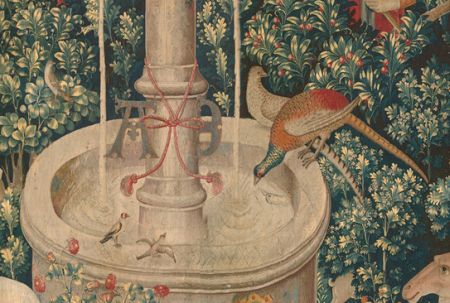« Back to Birdie Love, My Birdie Love
Detail from The Unicorn is Found, 1495???1505
South Netherlandish
Wool warp, wool, silk, silver, and gilt wefts; Overall: 12 ft. 1 in. x 12 ft. 5 in. (368.3 x 378.5 cm)
The Metropolitan Museum of Art, New York, Gift of John D. Rockefeller Jr. 1937 (37.80.2)
The pheasant admires his own beauty in the water of the basin. A medieval hunting manual, the Livre de chasse du Roy modus, explains that a male pheasant can be caught by showing him his reflection in a mirror—the bird will strike out repeatedly at his own image, believing it to be a rival, thus giving the captor time to bag him. The same source notes that the birds in a mated pair are always to be found together. A noble bird according to the hierarchies of the Middle Ages, the pheasant appears in a number of medieval tapestries.
Margaret Freeman notes that the adult male goldfinch seen here on the left is accompanied by a fledgling with outstretched wings; a third goldfinch perches in the medlar tree on the left of the tapestry. Goldfinches also appear in the third, fourth, and sixth tapestries.
The nightingale is the bird most associated with noble love in the Middles Ages. The cuckoo is the bird of illicit love. The nightingale is heard to speak in The Parlement of Foules. (Listen to a sample of the nightingale’s song)
See the Collection Database for an image of the full tapestry.

